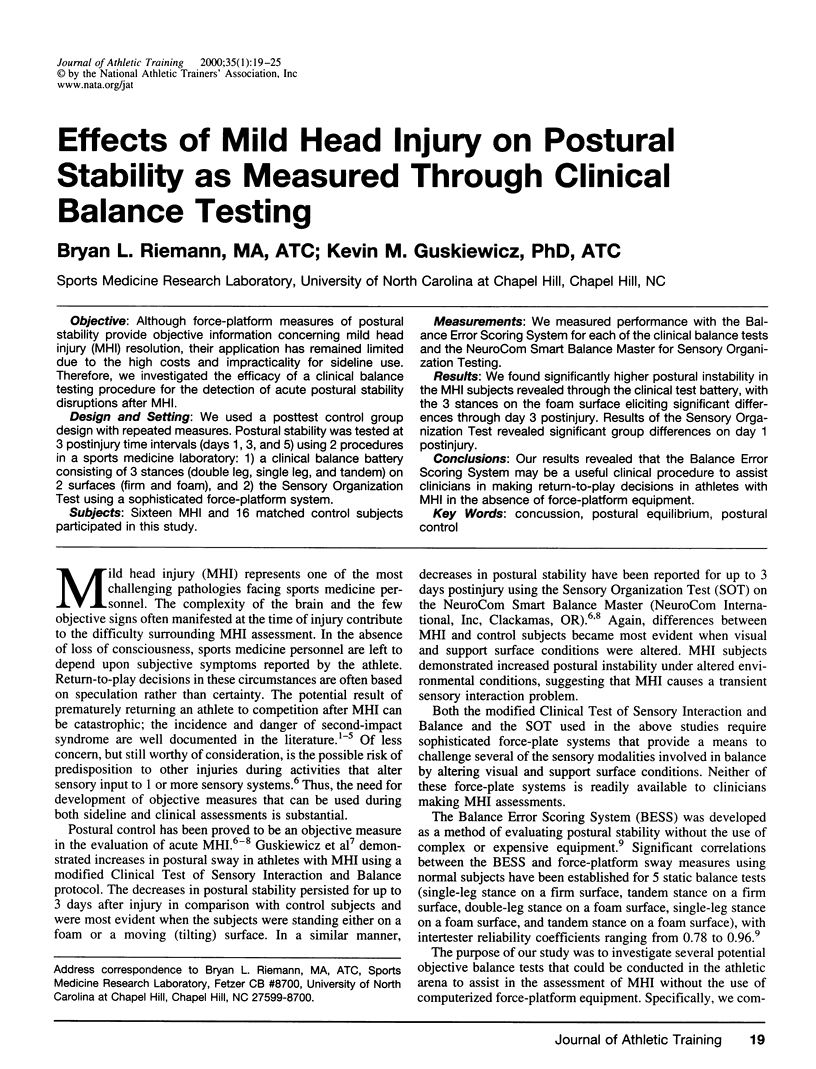Abstract
Objective:
Although force-platform measures of postural stability provide objective information concerning mild head injury (MHI) resolution, their application has remained limited due to the high costs and impracticality for sideline use. Therefore, we investigated the efficacy of a clinical balance testing procedure for the detection of acute postural stability disruptions after MHI.
Design and Setting:
We used a posttest control group design with repeated measures. Postural stability was tested at 3 postinjury time intervals (days 1, 3, and 5) using 2 procedures in a sports medicine laboratory: 1) a clinical balance battery consisting of 3 stances (double leg, single leg, and tandem) on 2 surfaces (firm and foam), and 2) the Sensory Organization Test using a sophisticated force-platform system.
Subjects:
Sixteen MHI and 16 matched control subjects participated in this study.
Measurements:
We measured performance with the Balance Error Scoring System for each of the clinical balance tests and the NeuroCom Smart Balance Master for Sensory Organization Testing.
Results:
We found significantly higher postural instability in the MHI subjects revealed through the clinical test battery, with the 3 stances on the foam surface eliciting significant differences through day 3 postinjury. Results of the Sensory Organization Test revealed significant group differences on day 1 postinjury.
Conclusions:
Our results revealed that the Balance Error Scoring System may be a useful clinical procedure to assist clinicians in making return-to-play decisions in athletes with MHI in the absence of force-platform equipment.
Keywords: concussion, postural equilibrium, postural control
Full text
PDF






Images in this article
Selected References
These references are in PubMed. This may not be the complete list of references from this article.
- Cantu R. C. Return to play guidelines after a head injury. Clin Sports Med. 1998 Jan;17(1):45–60. doi: 10.1016/s0278-5919(05)70060-0. [DOI] [PubMed] [Google Scholar]
- Cantu R. C. Second-impact syndrome. Clin Sports Med. 1998 Jan;17(1):37–44. doi: 10.1016/s0278-5919(05)70059-4. [DOI] [PubMed] [Google Scholar]
- Cevette M. J., Puetz B., Marion M. S., Wertz M. L., Muenter M. D. Aphysiologic performance on dynamic posturography. Otolaryngol Head Neck Surg. 1995 Jun;112(6):676–688. doi: 10.1016/S0194-59989570175-3. [DOI] [PubMed] [Google Scholar]
- Fekete J. F. Severe brain injury and death following minor hockey accidents: the effectiveness of the "safety helmets" of amateur hockey players. Can Med Assoc J. 1968 Dec 28;99(25):1234–1239. [PMC free article] [PubMed] [Google Scholar]
- Genuardi F. J., King W. D. Inappropriate discharge instructions for youth athletes hospitalized for concussion. Pediatrics. 1995 Feb;95(2):216–218. [PubMed] [Google Scholar]
- Goebel J. A., Sataloff R. T., Hanson J. M., Nashner L. M., Hirshout D. S., Sokolow C. C. Posturographic evidence of nonorganic sway patterns in normal subjects, patients, and suspected malingerers. Otolaryngol Head Neck Surg. 1997 Oct;117(4):293–302. doi: 10.1016/S0194-5998(97)70116-5. [DOI] [PubMed] [Google Scholar]
- Guskiewicz K. M., Perrin D. H., Gansneder B. M. Effect of mild head injury on postural stability in athletes. J Athl Train. 1996 Oct;31(4):300–306. [PMC free article] [PubMed] [Google Scholar]
- Guskiewicz K. M., Riemann B. L., Perrin D. H., Nashner L. M. Alternative approaches to the assessment of mild head injury in athletes. Med Sci Sports Exerc. 1997 Jul;29(7 Suppl):S213–S221. doi: 10.1097/00005768-199707001-00003. [DOI] [PubMed] [Google Scholar]
- Hamid M. A., Hughes G. B., Kinney S. E. Specificity and sensitivity of dynamic posturography. A retrospective analysis. Acta Otolaryngol Suppl. 1991;481:596–600. doi: 10.3109/00016489109131480. [DOI] [PubMed] [Google Scholar]
- Jacobson G. P., Newman C. W., Hunter L., Balzer G. K. Balance function test correlates of the Dizziness Handicap Inventory. J Am Acad Audiol. 1991 Oct;2(4):253–260. [PubMed] [Google Scholar]
- Kelly J. P., Nichols J. S., Filley C. M., Lillehei K. O., Rubinstein D., Kleinschmidt-DeMasters B. K. Concussion in sports. Guidelines for the prevention of catastrophic outcome. JAMA. 1991 Nov 27;266(20):2867–2869. doi: 10.1001/jama.266.20.2867. [DOI] [PubMed] [Google Scholar]
- Kelly J. P., Rosenberg J. H. Diagnosis and management of concussion in sports. Neurology. 1997 Mar;48(3):575–580. doi: 10.1212/wnl.48.3.575. [DOI] [PubMed] [Google Scholar]
- Leblanc K. E. Concussions in sports: guidelines for return to competition. Am Fam Physician. 1994 Sep 15;50(4):801–808. [PubMed] [Google Scholar]
- McCrory P. R., Berkovic S. F. Second impact syndrome. Neurology. 1998 Mar;50(3):677–683. doi: 10.1212/wnl.50.3.677. [DOI] [PubMed] [Google Scholar]
- Panosian M. S., Paige G. D. Nystagmus and postural instability after headshake in patients with vestibular dysfunction. Otolaryngol Head Neck Surg. 1995 Mar;112(3):399–404. doi: 10.1016/S0194-59989570273-3. [DOI] [PubMed] [Google Scholar]
- Rimel R. W., Giordani B., Barth J. T., Boll T. J., Jane J. A. Disability caused by minor head injury. Neurosurgery. 1981 Sep;9(3):221–228. [PubMed] [Google Scholar]
- Saunders R. L., Harbaugh R. E. The second impact in catastrophic contact-sports head trauma. JAMA. 1984 Jul 27;252(4):538–539. [PubMed] [Google Scholar]
- Warren W. L., Jr, Bailes J. E. On the field evaluation of athletic head injuries. Clin Sports Med. 1998 Jan;17(1):13–26. doi: 10.1016/s0278-5919(05)70057-0. [DOI] [PubMed] [Google Scholar]





